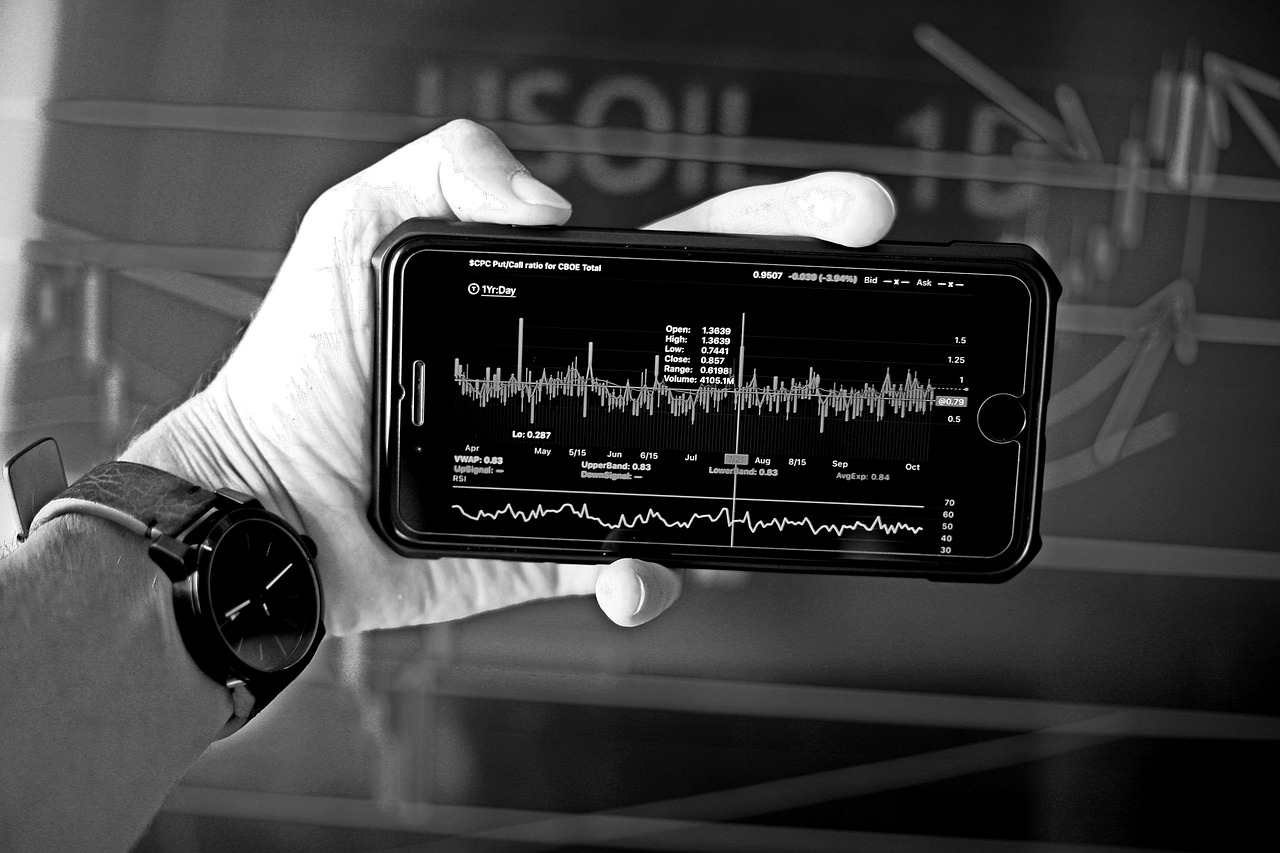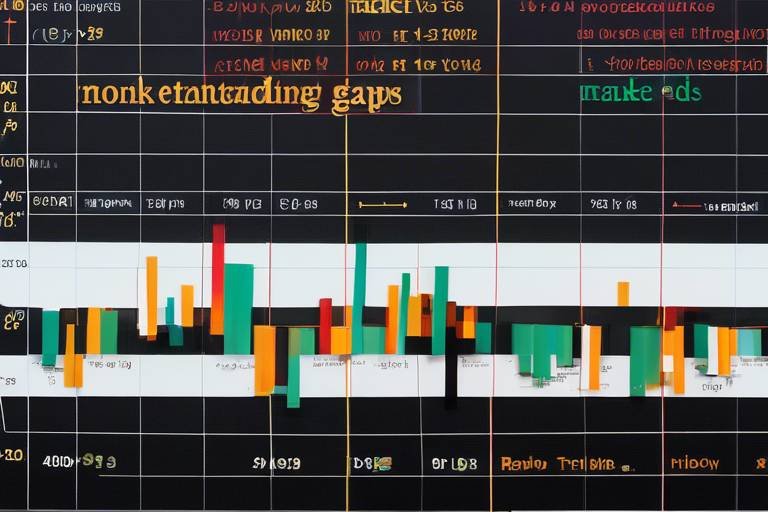Understanding Market Gaps - How They Affect Trading
Market gaps are a fascinating phenomenon in the world of trading that can significantly impact investment strategies and decision-making processes for traders and investors alike. But what exactly are these gaps, and why should you care? In simple terms, a market gap occurs when a security's price opens significantly higher or lower than its previous closing price. This sudden shift often indicates a change in the dynamics of supply and demand, which can present both risks and opportunities for traders.
Imagine you're watching your favorite stock, and it closes at $100 one day. The next morning, it opens at $110. That's a market gap—a clear sign that something has changed overnight, whether it be news, earnings reports, or market sentiment. Understanding the nature of these gaps is crucial for traders looking to navigate the ever-changing landscape of the market. It’s like trying to read the weather without knowing the forecast; you might get caught in a storm if you’re not prepared!
Market gaps can be categorized into several types, each serving a distinct purpose and signaling various market conditions. By grasping the different types of gaps, traders can better position themselves to take advantage of potential trading opportunities. The four main types of market gaps include common gaps, breakaway gaps, runaway gaps, and exhaustion gaps. Each type has its own characteristics and implications, which we will explore in detail throughout this article.
Understanding the different types of market gaps is essential for any trader looking to refine their strategies. Let’s break down these types:
- Common Gaps: Typically occur in stable market conditions and often fill quickly.
- Breakaway Gaps: Signal the start of a new trend and occur when the price breaks through significant support or resistance levels.
- Runaway Gaps: Also known as continuation gaps, these occur during strong trends and suggest that momentum is likely to continue.
- Exhaustion Gaps: Appear at the end of a trend and indicate a potential reversal.
By identifying these gaps, traders can make informed decisions that could lead to increased profitability. For example, recognizing a breakaway gap could prompt a trader to enter a position early in a new trend, while spotting an exhaustion gap might signal it’s time to exit a position before a reversal occurs.
Common gaps are often seen in stable market conditions and are usually filled quickly. They indicate temporary price movements and are less significant than other types of gaps. Understanding the characteristics of common gaps can help traders anticipate price movements and make informed decisions. For instance, if a trader notices a common gap during low-volume trading, they might choose to wait for confirmation before acting.
Common gaps tend to occur in low-volume trading environments and are often associated with minimal news or events that could impact the market significantly. Because they fill quickly, it’s crucial for traders to recognize these gaps and understand their implications. Think of it like a balloon; if you let air out slowly, it deflates gradually, but if you pop it, it’s a sudden change that can catch you off guard.
To effectively trade common gaps, traders can employ specific strategies, such as waiting for confirmation from other indicators before making a move. This approach minimizes risks associated with these temporary price movements. By being patient and observing market behavior, traders can make smarter decisions and avoid unnecessary losses.
Breakaway gaps are significant because they signify the start of a new trend. These gaps occur when the price breaks through a significant support or resistance level, indicating a shift in market sentiment. Recognizing breakaway gaps can lead to profitable trades, as they often mark the beginning of a sustained price movement.
Runaway gaps, or continuation gaps, occur during a strong trend and indicate that momentum is likely to continue. Traders can leverage these gaps to capitalize on ongoing price movements, effectively riding the wave of the trend. Identifying runaway gaps involves analyzing market trends and volume, which can enhance trading strategies and improve profitability.
To identify runaway gaps, traders should pay attention to market trends and volume. A significant increase in volume alongside a runaway gap can confirm the strength of the trend, providing traders with the confidence to enter positions. Just like spotting a wave while surfing, recognizing these gaps can help traders catch the momentum and ride it to success.
Exhaustion gaps appear at the end of a trend and signal a potential reversal. Understanding these gaps is vital for traders looking to exit positions or adjust their strategies accordingly. If a trader identifies an exhaustion gap, it may be time to reassess their position, much like a driver who notices a red light ahead and prepares to stop.
Q: What causes market gaps?
A: Market gaps are typically caused by significant news, earnings reports, or changes in market sentiment that affect supply and demand dynamics.
Q: Are all market gaps significant?
A: Not all gaps are significant. Common gaps tend to fill quickly and are less impactful, while breakaway and runaway gaps can indicate strong trading opportunities.
Q: How can I trade market gaps effectively?
A: To trade market gaps effectively, it's essential to understand the type of gap, wait for confirmation, and analyze market trends and volume.

What Are Market Gaps?
Market gaps are fascinating phenomena in the world of trading. They occur when a security's price opens significantly higher or lower than its previous closing price, creating a "gap" in the price chart. This can happen for various reasons, such as after a major news announcement or earnings report, which can dramatically shift supply and demand dynamics. Understanding market gaps is crucial for traders as they can provide valuable insights into potential price movements and market trends.
Imagine you’re driving down a road and suddenly encounter a gap where the pavement has crumbled away. You have to decide whether to navigate around it or take a leap of faith. Similarly, in trading, market gaps represent opportunities and risks that traders must navigate. When a gap occurs, it signals that something significant has happened in the market, prompting traders to reassess their strategies and positions.
Market gaps can be categorized into different types, each with its unique characteristics and implications. For example, if a stock opens much higher than its previous close due to positive news, it may suggest strong buying interest. Conversely, if a stock opens lower, it may indicate panic selling. Understanding these dynamics helps traders make informed decisions. Here are some key aspects of market gaps:
- Indication of Market Sentiment: Gaps often reflect the overall sentiment of the market, whether bullish or bearish.
- Volume Consideration: The trading volume accompanying a gap can provide additional context. Higher volume often indicates stronger conviction behind the price movement.
- Potential for Price Reversal: Some gaps may signal potential reversals, making them critical for traders looking to enter or exit positions.
In summary, market gaps are not just random occurrences; they are significant signals that can influence trading strategies. By understanding what market gaps are and how they operate, traders can better position themselves to take advantage of potential opportunities while managing risks effectively.

Types of Market Gaps
This article explores the concept of market gaps, their significance in trading, and how they can influence investment strategies and decision-making processes for traders and investors alike.
Market gaps occur when a security's price opens significantly higher or lower than its previous closing price, indicating a change in supply and demand dynamics. Understanding their nature is crucial for traders.
Market gaps can be categorized into several distinct types, each with its own implications for traders and investors. These gaps are not just random occurrences; they provide insight into market psychology and can signal potential trading opportunities. The primary types of market gaps include common gaps, breakaway gaps, runaway gaps, and exhaustion gaps. Understanding these types can significantly enhance a trader's ability to navigate the market effectively.
Common gaps are typically seen in stable market conditions and often fill quickly, indicating a temporary price movement. These gaps are usually the result of minor news events or fluctuations in market sentiment. Traders should recognize these gaps to make informed decisions, as they often signal a return to the previous price levels.
Common gaps usually occur in low-volume trading and are less significant than other types. They often appear in the middle of a trend rather than at the beginning or end. Understanding their characteristics can help traders anticipate price movements. For instance, common gaps may indicate a lack of conviction in the current price direction, prompting traders to exercise caution.
To effectively trade common gaps and minimize risks associated with these price movements, traders can employ specific strategies. One approach is to wait for confirmation through subsequent price action before making a trade. This can involve observing whether the price quickly fills the gap or continues to move in the gap's direction. By doing so, traders can enhance their decision-making process and improve their chances of success.
Breakaway gaps signify the start of a new trend and occur when the price breaks through a significant support or resistance level. These gaps are often accompanied by high trading volume, indicating strong market interest and conviction. Recognizing these gaps can lead to profitable trades, as they often mark the beginning of a substantial price movement.
Runaway gaps, or continuation gaps, occur during a strong trend and indicate that the momentum is likely to continue. These gaps suggest that the market participants are still enthusiastic about the direction of the trend, making them an excellent opportunity for traders to capitalize on ongoing price movements.
Identifying runaway gaps involves analyzing market trends and volume. Traders should look for gaps that occur in the direction of the trend, accompanied by an increase in trading volume. Successful recognition can enhance trading strategies and improve the chances of profitability, as it allows traders to align their positions with the prevailing market momentum.
Exhaustion gaps appear at the end of a trend and signal a potential reversal. These gaps often occur after a prolonged price movement, suggesting that the buying or selling pressure is waning. Understanding these gaps is vital for traders looking to exit positions or adjust strategies accordingly. Recognizing an exhaustion gap can help traders lock in profits before a potential trend reversal occurs.
What is a market gap?
A market gap occurs when a security's price opens significantly higher or lower than its previous closing price, indicating a shift in supply and demand dynamics.
How many types of market gaps are there?
There are four primary types of market gaps: common gaps, breakaway gaps, runaway gaps, and exhaustion gaps. Each type serves a different purpose and can signal various market conditions.
How can I trade common gaps effectively?
To trade common gaps effectively, it is advisable to wait for confirmation through subsequent price action before making a trade, helping to minimize risks.
What do runaway gaps indicate?
Runaway gaps indicate that the momentum of an existing trend is likely to continue, providing traders with opportunities to capitalize on ongoing price movements.
Why are exhaustion gaps important?
Exhaustion gaps are important because they signal a potential reversal at the end of a trend, allowing traders to make timely decisions to exit positions or adjust strategies.

Common Gaps
Common gaps are a fascinating phenomenon in the trading world, often seen during stable market conditions. They occur when a security's price opens significantly higher or lower than its previous closing price, yet they tend to fill quickly. This means that the price usually retraces back to the previous level, indicating that the gap was merely a temporary price movement rather than a significant change in market sentiment. Think of it like a balloon that pops back into shape after being squeezed; the price may stretch out temporarily, but it often returns to its original form.
One of the defining characteristics of common gaps is their occurrence during low-volume trading sessions. Since there isn’t a lot of trading activity, these gaps can appear more pronounced than they truly are. Traders should recognize these gaps for what they are—temporary blips in price rather than signals of a new trend. Understanding the context in which these gaps arise is crucial for making informed trading decisions.
To effectively navigate common gaps, traders can employ specific strategies. For instance, waiting for confirmation from other indicators can help minimize risks associated with these price movements. It's like waiting for the dust to settle after a storm; only then can you assess the damage and make a sound decision. Traders might look for additional signals, such as volume spikes or price action, to confirm whether the gap is indeed a fleeting moment or a precursor to something more significant.
In summary, while common gaps may not seem like a big deal at first glance, they can offer valuable insights into market behavior. By understanding their characteristics and employing effective strategies, traders can turn these seemingly minor occurrences into profitable opportunities. Remember, the key is to stay patient and vigilant, always ready to adapt to the ever-changing market landscape.
- What causes common gaps? Common gaps are typically caused by low trading volume and can occur when traders react to news or events that happen after market hours.
- Are common gaps reliable indicators for trading? While they can provide insights, common gaps are generally less reliable than other types of gaps, as they tend to fill quickly.
- How can I identify a common gap? Look for price movements that occur at the market open, which are significantly different from the previous day's closing price, especially during low-volume trading periods.
- What strategies can I use to trade common gaps? Strategies include waiting for confirmation through additional indicators, analyzing volume, and being cautious about the potential for the gap to fill.

Characteristics of Common Gaps
This article explores the concept of market gaps, their significance in trading, and how they can influence investment strategies and decision-making processes for traders and investors alike.
Market gaps occur when a security's price opens significantly higher or lower than its previous closing price, indicating a change in supply and demand dynamics. Understanding their nature is crucial for traders.
There are several types of market gaps, including common, breakaway, runaway, and exhaustion gaps. Each type serves a different purpose and can signal various market conditions and potential trading opportunities.
Common gaps are typically seen in stable market conditions and often fill quickly, indicating a temporary price movement. Traders should recognize these gaps to make informed decisions.
Common gaps have several distinctive features that set them apart from other types of gaps. Firstly, they usually occur in low-volume trading environments, which means that the price movement is not backed by strong buying or selling pressure. This characteristic often leads to a quick filling of the gap, as the market seeks to correct the price discrepancy.
Another important aspect of common gaps is their transitory nature. Because they often arise from routine fluctuations rather than significant news events or changes in market sentiment, they tend to close relatively quickly. Traders should keep an eye on these gaps, as they can signal potential reversals or continuations in price trends.
Furthermore, common gaps are generally less significant than other gap types. They do not usually indicate a strong shift in market sentiment or the beginning of a new trend. Instead, they reflect minor adjustments in the market, often leading to limited price movement. Understanding these characteristics can help traders anticipate price movements and make more informed trading decisions.
To summarize, here are the key characteristics of common gaps:
- Low trading volume: Common gaps often appear in periods of low trading activity.
- Temporary price movements: These gaps tend to fill quickly as the market corrects itself.
- Less significant: They usually do not indicate major shifts in market sentiment or trends.
Traders can employ specific strategies, like waiting for confirmation, to effectively trade common gaps and minimize risks associated with these price movements.
Breakaway gaps signify the start of a new trend and occur when the price breaks through a significant support or resistance level. Recognizing these gaps can lead to profitable trades.
Runaway gaps, or continuation gaps, occur during a strong trend and indicate the momentum is likely to continue. Traders can leverage these gaps to capitalize on ongoing price movements.
Identifying runaway gaps involves analyzing market trends and volume. Successful recognition can enhance trading strategies and improve the chances of profitability.
Exhaustion gaps appear at the end of a trend and signal a potential reversal. Understanding these gaps is vital for traders looking to exit positions or adjust strategies accordingly.
1. What causes market gaps?
Market gaps are typically caused by sudden changes in supply and demand, often due to news events, earnings reports, or economic data releases.
2. Are all gaps significant?
No, not all gaps are significant. Common gaps are often less important than breakaway or exhaustion gaps, which indicate stronger market movements.
3. How can I trade gaps effectively?
Effective gap trading involves recognizing the type of gap, using volume analysis, and waiting for confirmation before making trading decisions.
4. Can gaps be filled?
Yes, many gaps, especially common gaps, tend to fill quickly as the market corrects itself, but not all gaps will be filled.

Strategies for Trading Common Gaps
Trading common gaps can often feel like navigating a maze; it requires a keen sense of direction and an understanding of the nuances involved. These gaps, which typically occur in stable market conditions, can provide unique opportunities for traders. However, to effectively harness their potential, it’s essential to adopt well-thought-out strategies. One effective approach is to wait for confirmation before entering a trade. This means observing the price movement after the gap has occurred. If the price quickly retraces to fill the gap, it may signal a temporary price movement, which could indicate a good entry point for traders.
Another strategy involves using technical indicators to support your decision-making process. For instance, combining gap analysis with moving averages or Relative Strength Index (RSI) can provide additional insights into whether the price is likely to continue its movement or reverse. By layering these indicators, you gain a more comprehensive view of the market dynamics at play.
Moreover, understanding the volume associated with the gap is crucial. Low-volume gaps often indicate weaker movements that may not sustain themselves, while higher volume can signal stronger momentum. Therefore, always pay attention to volume trends when evaluating common gaps. If the gap occurs with significant volume, it may suggest a more reliable price movement and a greater likelihood of continuation.
Additionally, consider your risk management strategies. Setting stop-loss orders just below the gap can help protect your investment in case the market turns against you. This approach allows you to limit potential losses while still taking advantage of the gap's opportunities. Remember, trading is not just about seizing opportunities; it’s also about managing risk effectively.
In summary, trading common gaps requires a combination of patience, analysis, and risk management. By waiting for confirmation, utilizing technical indicators, observing volume, and implementing solid risk management strategies, traders can position themselves to make informed decisions that enhance their trading outcomes.
- What is a market gap? A market gap occurs when a security's price opens significantly higher or lower than its previous closing price, reflecting changes in supply and demand dynamics.
- How can I identify common gaps? Common gaps are typically characterized by low trading volume and often fill quickly. They usually occur in stable market conditions.
- What is the best strategy for trading common gaps? Waiting for confirmation of the gap, using technical indicators, and paying attention to trading volume are effective strategies for trading common gaps.
- Are common gaps always filled? While many common gaps are filled, it is not guaranteed. Traders should analyze the market context and use risk management strategies.

Breakaway Gaps
This article explores the concept of market gaps, their significance in trading, and how they can influence investment strategies and decision-making processes for traders and investors alike.
Market gaps occur when a security's price opens significantly higher or lower than its previous closing price, indicating a change in supply and demand dynamics. Understanding their nature is crucial for traders.
There are several types of market gaps, including common, breakaway, runaway, and exhaustion gaps. Each type serves a different purpose and can signal various market conditions and potential trading opportunities.
Common gaps are typically seen in stable market conditions and often fill quickly, indicating a temporary price movement. Traders should recognize these gaps to make informed decisions.
Common gaps usually occur in low-volume trading and are less significant than other types. Understanding their characteristics can help traders anticipate price movements.
Traders can employ specific strategies, like waiting for confirmation, to effectively trade common gaps and minimize risks associated with these price movements.
Breakaway gaps are a fascinating phenomenon in the trading world, acting as the heralds of new trends. They occur when a security's price decisively breaks through a significant support or resistance level, often accompanied by a surge in volume. This sudden shift signifies that the previous trend is losing its grip, and a new direction is emerging. For traders, recognizing these gaps can be the key to unlocking profitable opportunities.
Imagine you're standing at the edge of a cliff, observing the vast ocean below. When the waves crash against the rocks, they create a powerful force that can either erode the cliff or propel you forward into the water. In a similar way, breakaway gaps can propel a trader into a new trend, providing the momentum needed to ride the wave of price movement.
To effectively harness the potential of breakaway gaps, traders should consider a few critical factors:
- Volume Analysis: A significant increase in trading volume during the gap is a strong indicator of its validity. High volume suggests that many traders are participating in the move, reinforcing the strength of the new trend.
- Market Sentiment: Understanding the overall market sentiment can help traders gauge whether the gap aligns with broader trends. A breakaway gap in a bullish market may present different opportunities compared to one in a bearish environment.
- Confirmation Signals: Waiting for additional confirmation, such as a follow-up price movement in the same direction, can help traders avoid false breakouts that could lead to losses.
In summary, breakaway gaps are not just random occurrences; they are powerful signals that can guide traders toward new opportunities. By paying attention to volume, market sentiment, and confirmation signals, traders can make informed decisions and potentially capitalize on the momentum that these gaps create.
Runaway gaps, or continuation gaps, occur during a strong trend and indicate the momentum is likely to continue. Traders can leverage these gaps to capitalize on ongoing price movements.
Identifying runaway gaps involves analyzing market trends and volume. Successful recognition can enhance trading strategies and improve the chances of profitability.
Exhaustion gaps appear at the end of a trend and signal a potential reversal. Understanding these gaps is vital for traders looking to exit positions or adjust strategies accordingly.
- What causes market gaps? Market gaps are primarily caused by changes in supply and demand, often triggered by news events, earnings reports, or economic indicators that influence investor sentiment.
- Are all market gaps significant? Not all gaps are created equal. Common gaps tend to fill quickly and may not indicate a strong trend, while breakaway and runaway gaps can signal more substantial market movements.
- How can I trade breakaway gaps effectively? To trade breakaway gaps effectively, look for increased volume, confirm the trend direction with additional signals, and consider using stop-loss orders to manage risk.

Runaway Gaps
Runaway gaps, often referred to as continuation gaps, are fascinating phenomena in the trading world. They occur during a strong trend, whether bullish or bearish, and signify that the momentum is likely to persist. Imagine you're on a roller coaster, and just as you reach the peak, the ride suddenly drops—this is akin to what happens in the market when a runaway gap appears. Traders can capitalize on these gaps to enhance their trading strategies and potentially increase their profits.
Understanding runaway gaps is essential for traders who want to ride the wave of momentum. Typically, these gaps occur when the price of a security opens significantly higher or lower than its previous closing price, reflecting a shift in market sentiment. The key to identifying runaway gaps lies in analyzing the context in which they appear. For instance, if a stock has been on an upward trajectory and suddenly opens much higher, it can signal that buyers are still in control, pushing the price even further.
To effectively leverage runaway gaps, traders should consider a few critical factors:
- Volume Analysis: A significant increase in trading volume accompanying the gap is a strong indicator of continued momentum. Higher volume suggests that more participants are willing to buy or sell at the new price levels, reinforcing the gap's validity.
- Market Sentiment: Keeping an eye on overall market sentiment can provide clues about the sustainability of the gap. If the broader market is bullish, a runaway gap in a particular stock may indicate strong buying interest.
- Technical Indicators: Utilizing technical indicators, such as moving averages or momentum indicators, can help traders confirm the strength of the trend and the likelihood of the gap continuing.
It's also important to recognize that while runaway gaps can present lucrative opportunities, they are not without risks. Traders should always have a plan in place for managing their positions. For example, setting stop-loss orders can help protect against sudden reversals that may occur after the gap. Additionally, understanding the market environment—whether it's a news-driven event or an earnings report—can provide valuable insights into the potential longevity of the gap.
In summary, runaway gaps are powerful indicators of ongoing market momentum. By analyzing volume, market sentiment, and technical indicators, traders can make informed decisions that align with the prevailing trend. However, as with any trading strategy, it's crucial to remain vigilant and prepared for any shifts in market dynamics.
What is a runaway gap?
A runaway gap, or continuation gap, occurs during a strong trend and indicates that the momentum is likely to continue. It typically opens significantly higher or lower than the previous closing price.
How can I identify a runaway gap?
To identify a runaway gap, look for significant price movement accompanied by increased trading volume and favorable market sentiment. Analyzing these factors can help confirm the gap's strength.
What should I do if I spot a runaway gap?
If you spot a runaway gap, consider entering a position that aligns with the prevailing trend. However, always manage your risk with stop-loss orders and stay informed about market conditions.

Identifying Runaway Gaps
Identifying runaway gaps is crucial for traders who want to take advantage of ongoing trends in the market. These gaps often occur during strong price movements and can indicate that momentum is likely to continue. But how can you spot these gaps effectively? It's not just about looking for the gaps themselves; you also need to analyze the surrounding context. For instance, consider the trending direction of the market before the gap occurs. If the price has been consistently rising or falling, and suddenly there’s a gap in the same direction, it’s a strong signal that the trend may persist.
Moreover, volume plays a significant role in confirming runaway gaps. A gap accompanied by high trading volume suggests that the move is backed by strong investor interest, making it more likely that the trend will continue. Conversely, if the gap occurs with low volume, it might indicate a lack of conviction among traders, which could lead to a reversal. Therefore, always pay attention to volume trends alongside gap analysis.
To make it easier for you to understand the characteristics of runaway gaps, here’s a simple table that summarizes key points:
| Characteristic | Importance |
|---|---|
| Direction of the Gap | Should align with the existing trend (upward or downward). |
| Volume | High volume supports the strength of the gap. |
| Market Sentiment | Positive sentiment for upward gaps and negative for downward gaps. |
In addition to these factors, traders should also consider the overall market conditions. Are there any significant economic announcements or events that could impact the market? For example, earnings reports or economic data releases can create volatility and lead to runaway gaps. Understanding the broader context helps in making informed decisions. So, before diving into a trade based solely on a runaway gap, take a moment to evaluate the entire landscape.
Finally, it’s essential to have a solid trading plan in place. This plan should outline your entry and exit strategies based on the identification of runaway gaps. Will you set stop-loss orders to manage your risk? How will you determine when to take profits? By being prepared, you can navigate the thrilling yet unpredictable waters of trading with greater confidence.

Exhaustion Gaps
Exhaustion gaps are fascinating phenomena in the world of trading, often serving as a crucial indicator for traders who are keen on timing their entries and exits. These gaps typically appear at the end of a prevailing trend, signaling that the momentum driving the price movement is fading. Imagine a runner who has sprinted to the finish line; they might start strong but eventually slow down, indicating that the race is over. Similarly, exhaustion gaps suggest that the bullish or bearish trend is losing steam, and a reversal could be imminent.
Recognizing exhaustion gaps is vital for any trader looking to protect their investments or capitalize on potential reversals. These gaps can manifest when the price opens significantly higher or lower than the previous day's closing price, often accompanied by a notable decrease in volume. This decrease in trading volume can be likened to a party that’s winding down; the energy is fading, and it might be time to leave before things get dull. Traders should be on the lookout for these signs, as they can provide valuable insights into market sentiment.
To effectively navigate exhaustion gaps, it's essential to consider a few key characteristics:
- Volume Analysis: A significant drop in volume during the formation of the gap can indicate that the trend is losing its strength.
- Price Action: Observing the price movement following the gap can help traders determine whether the market is indeed reversing or simply experiencing a temporary pullback.
- Market Sentiment: Understanding the broader market context can provide clues about whether the gap is a genuine signal of a trend reversal or just noise.
Incorporating these factors into your trading strategy can enhance your ability to make informed decisions. For instance, if you spot an exhaustion gap after a prolonged uptrend, it might be wise to consider taking profits or tightening stop-loss orders. Conversely, if you see an exhaustion gap following a downtrend, it could present a buying opportunity as the market may be poised for a rebound.
In summary, exhaustion gaps are critical signals that traders should not overlook. They provide insight into the potential reversal of trends, allowing for strategic adjustments in trading plans. By understanding the characteristics and implications of exhaustion gaps, traders can position themselves more effectively in the ever-changing landscape of the market.
- What is an exhaustion gap? An exhaustion gap occurs at the end of a trend, indicating that the current momentum is fading and a reversal may be imminent.
- How can I identify an exhaustion gap? Look for a significant price move that opens above or below the previous day's close, combined with a decrease in trading volume.
- What should I do if I see an exhaustion gap? Consider adjusting your trading strategy, such as taking profits or placing tighter stop-loss orders, to mitigate risks associated with potential reversals.
Frequently Asked Questions
- What are market gaps?
Market gaps occur when a security's price opens significantly higher or lower than its previous closing price. This indicates a shift in supply and demand dynamics, which is crucial for traders to understand in order to make informed decisions.
- What are the different types of market gaps?
There are several types of market gaps including common, breakaway, runaway, and exhaustion gaps. Each type serves a unique purpose and signals different market conditions, providing various trading opportunities for investors.
- How do I identify common gaps?
Common gaps are typically characterized by low trading volume and often fill quickly. They occur in stable market conditions, and recognizing these can help traders anticipate short-term price movements.
- What strategies can I use for trading common gaps?
To effectively trade common gaps, traders can employ strategies such as waiting for confirmation of a price movement before entering a trade. This minimizes risks and helps in making informed decisions.
- What are breakaway gaps?
Breakaway gaps signify the beginning of a new trend and occur when the price breaks through significant support or resistance levels. Recognizing these gaps can lead to potentially profitable trades.
- What are runaway gaps?
Runaway gaps, also known as continuation gaps, occur during a strong trend and suggest that the momentum is likely to continue. Traders can leverage these gaps to capitalize on ongoing price movements.
- How can I identify runaway gaps?
Identifying runaway gaps involves analyzing market trends and volume. Successful recognition of these gaps can enhance trading strategies and improve the chances of profitability.
- What are exhaustion gaps?
Exhaustion gaps appear at the end of a trend and signal a potential reversal. Understanding these gaps is vital for traders looking to exit positions or adjust their strategies accordingly.



















